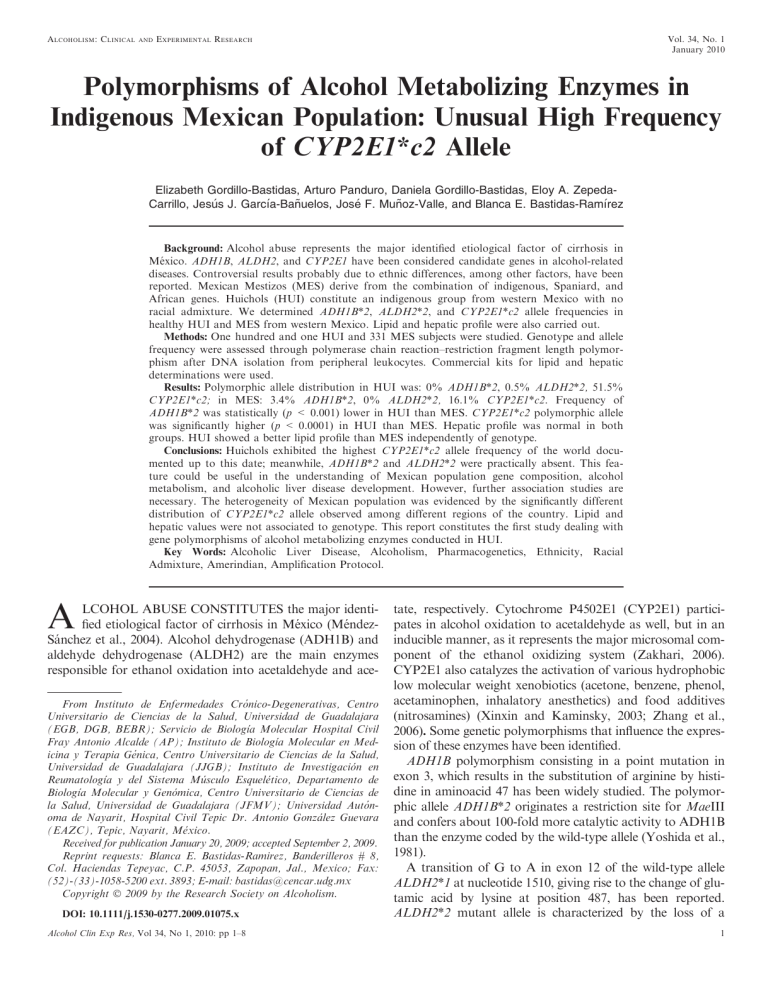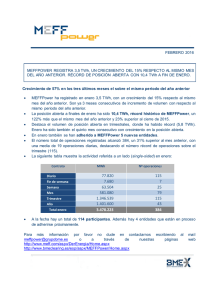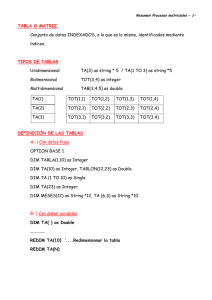Polymorphisms of Alcohol metabolizing enzymes in indigenous mexican population 2010
Anuncio

Vol. 34, No. 1 January 2010 Alcoholism: Clinical and Experimental Research Polymorphisms of Alcohol Metabolizing Enzymes in Indigenous Mexican Population: Unusual High Frequency of CYP2E1*c2 Allele Elizabeth Gordillo-Bastidas, Arturo Panduro, Daniela Gordillo-Bastidas, Eloy A. ZepedaCarrillo, Jesús J. Garcı́a-Bañuelos, José F. Muñoz-Valle, and Blanca E. Bastidas-Ramı́rez Background: Alcohol abuse represents the major identified etiological factor of cirrhosis in México. ADH1B, ALDH2, and CYP2E1 have been considered candidate genes in alcohol-related diseases. Controversial results probably due to ethnic differences, among other factors, have been reported. Mexican Mestizos (MES) derive from the combination of indigenous, Spaniard, and African genes. Huichols (HUI) constitute an indigenous group from western Mexico with no racial admixture. We determined ADH1B*2, ALDH2*2, and CYP2E1*c2 allele frequencies in healthy HUI and MES from western Mexico. Lipid and hepatic profile were also carried out. Methods: One hundred and one HUI and 331 MES subjects were studied. Genotype and allele frequency were assessed through polymerase chain reaction–restriction fragment length polymorphism after DNA isolation from peripheral leukocytes. Commercial kits for lipid and hepatic determinations were used. Results: Polymorphic allele distribution in HUI was: 0% ADH1B*2, 0.5% ALDH2*2, 51.5% CYP2E1*c2; in MES: 3.4% ADH1B*2, 0% ALDH2*2, 16.1% CYP2E1*c2. Frequency of ADH1B*2 was statistically (p < 0.001) lower in HUI than MES. CYP2E1*c2 polymorphic allele was significantly higher (p < 0.0001) in HUI than MES. Hepatic profile was normal in both groups. HUI showed a better lipid profile than MES independently of genotype. Conclusions: Huichols exhibited the highest CYP2E1*c2 allele frequency of the world documented up to this date; meanwhile, ADH1B*2 and ALDH2*2 were practically absent. This feature could be useful in the understanding of Mexican population gene composition, alcohol metabolism, and alcoholic liver disease development. However, further association studies are necessary. The heterogeneity of Mexican population was evidenced by the significantly different distribution of CYP2E1*c2 allele observed among different regions of the country. Lipid and hepatic values were not associated to genotype. This report constitutes the first study dealing with gene polymorphisms of alcohol metabolizing enzymes conducted in HUI. Key Words: Alcoholic Liver Disease, Alcoholism, Pharmacogenetics, Ethnicity, Racial Admixture, Amerindian, Amplification Protocol. A LCOHOL ABUSE CONSTITUTES the major identified etiological factor of cirrhosis in México (MéndezSánchez et al., 2004). Alcohol dehydrogenase (ADH1B) and aldehyde dehydrogenase (ALDH2) are the main enzymes responsible for ethanol oxidation into acetaldehyde and ace- From Instituto de Enfermedades Crónico-Degenerativas, Centro Universitario de Ciencias de la Salud, Universidad de Guadalajara (EGB, DGB, BEBR); Servicio de Biologı´a Molecular Hospital Civil Fray Antonio Alcalde (AP); Instituto de Biologı´a Molecular en Medicina y Terapia Génica, Centro Universitario de Ciencias de la Salud, Universidad de Guadalajara (JJGB); Instituto de Investigación en Reumatologı´a y del Sistema Músculo Esquele´tico, Departamento de Biologı´a Molecular y Genómica, Centro Universitario de Ciencias de la Salud, Universidad de Guadalajara (JFMV); Universidad Autónoma de Nayarit, Hospital Civil Tepic Dr. Antonio González Guevara (EAZC), Tepic, Nayarit, Me´xico. Received for publication January 20, 2009; accepted September 2, 2009. Reprint requests: Blanca E. Bastidas-Ramirez, Banderilleros # 8, Col. Haciendas Tepeyac, C.P. 45053, Zapopan, Jal., Mexico; Fax: (52)-(33)-1058-5200 ext. 3893; E-mail: bastidas@cencar.udg.mx Copyright 2009 by the Research Society on Alcoholism. DOI: 10.1111/j.1530-0277.2009.01075.x Alcohol Clin Exp Res, Vol 34, No 1, 2010: pp 1–8 tate, respectively. Cytochrome P4502E1 (CYP2E1) participates in alcohol oxidation to acetaldehyde as well, but in an inducible manner, as it represents the major microsomal component of the ethanol oxidizing system (Zakhari, 2006). CYP2E1 also catalyzes the activation of various hydrophobic low molecular weight xenobiotics (acetone, benzene, phenol, acetaminophen, inhalatory anesthetics) and food additives (nitrosamines) (Xinxin and Kaminsky, 2003; Zhang et al., 2006). Some genetic polymorphisms that influence the expression of these enzymes have been identified. ADH1B polymorphism consisting in a point mutation in exon 3, which results in the substitution of arginine by histidine in aminoacid 47 has been widely studied. The polymorphic allele ADH1B*2 originates a restriction site for MaeIII and confers about 100-fold more catalytic activity to ADH1B than the enzyme coded by the wild-type allele (Yoshida et al., 1981). A transition of G to A in exon 12 of the wild-type allele ALDH2*1 at nucleotide 1510, giving rise to the change of glutamic acid by lysine at position 487, has been reported. ALDH2*2 mutant allele is characterized by the loss of a 1 2 GORDILLO-BASTIDAS ET AL. Ksp632I restriction site and a resulting enzyme with little or no catalytic activity (Crabb et al., 1989; Hsu et al., 1985). CYP2E1 polymorphism at the 5¢ flanking regulatory region consisting in the substitution of C by T at position )1019, leads to the lack of an RsaI restriction site. Compared with the most common allele (c1), polymorphic allele (c2) is associated with a 10-fold higher transcriptional activity, elevated protein level, and increased enzymatic activity (Hayashi et al., 1991; Tsutsumi et al., 1994; Ueno et al., 1996; Ueshima et al., 1996). Adverse reactions due to acetaldehyde accumulation in the oxidative pathway of ethanol constitute the phenotypical characteristic conferred by ADH1B*2, ALDH2*2, and CYP2E1*c2 polymorphic alleles (Harada et al., 1982; Higuchi, 1994). These gene polymorphisms, lipid alteration, and oxidative stress represent some genetic and environmental factors that have been associated to liver impairment (Bataller and Brenner, 2005; Bataller et al., 2003; Hernández-Nazará et al., 2008; LeCouteur et al., 2007; Matsuzawa et al., 2007). On the other hand, ADH1B*2 and ALDH2*2 alleles have been associated with a lesser consumption of alcohol and called ‘‘protector alleles’’ by some authors. However, controversial results are reported (Bosron and Li, 1986; Vidal et al., 2004; Zintzaras et al., 2006) probably because heterogeneity and racial admixture is playing an important role, among other factors. Mexican population has been arisen by the admixture of indigenous, Spaniard, and African genes (Jimenez-Sanchez et al., 2008). Therefore, elucidation of the genomic structure of ethnic groups constitute significant contributions to this topic. Some reports exist in populations of Mexican origin regarding these polymorphisms, but studies in indigenous Mexican groups are very scarce, maybe because the access to them is usually very difficult. México is one of the 20 most populous countries accounting for 1.6% of the world population with approximately 103 million people (INEGI, 2006), including 62 different identified ethnic groups comprising approximately 12 million people. The heterogeneity of Mexican population may influence genotype distribution from region to region. Huichols (HUI) constitute an indigenous group of western central Mexico, living in the Sierra Madre Occidental in the states of Nayarit, Jalisco, Zacatecas, and Durango (CDI, 2008). The goal of this study was to assess genotype and allele frequency of ADH1B, ALDH2, and CYP2E1 polymorphisms in healthy HUI and Mexican mestizos (MES) from western Mexico and to compare them with other populations around the world. Lipid profile and functional hepatic tests were also performed in order to evaluate biochemical variations associated to polymorphisms. This is the first study conducted in HUI analyzing polymorphisms of the enzymes involved in ethanol metabolism. SUBJECTS AND METHODS Study Population One hundred and one HUI and 331 MES clinically healthy representing the general population reporting a Mexican family history of at least 3 generations, were included in this study. MES population was constituted by health workers and students of western Mexican origin from the Civil Hospital of Tepic, an urban population located approximately 210 km apart from the HUI community. HUI were recruited at a rural medical service after advertisement through their own HUI governor. Indigenous ethnicity was self declared by the use of traditional attire and HUI language, participation in ancestral religious ceremonies and living in a rural community of high degree of poverty known as ‘‘Jesús Marı́a,’’ at the mountains in Sierra Madre Occidental (INEGI, 2006). Blood Samples Peripheral blood samples were collected in plain tubes for biochemical determinations and EDTA containing tubes for DNA isolation and molecular analysis. Lipid and hepatic function profile were performed in all the individuals included in our study. ADH1B polymorphism was assessed in 97 HUI and 218 MES, ALDH2 in 101 HUI and 227 MES, CYP2E1 in 99 HUI, and 239 MES. DNA Isolation Genomic DNA was isolated by modified Miller’s procedure (Cuevas-Covarrubias et al., 2002; Miller et al., 1988). Briefly, EDTA-whole blood was transferred to a 15-ml sterile polystyrene conic tube and 3 ml of TTS (1 M baseTris pH 7.6 ⁄ 100 · Triton ⁄ 1 M sucrose), were added. After mixing, the tube was centrifuged at 4500·g for 10 minutes at room temperature. Supernatant was discarded and the pellet resuspended in 1 ml TTS, mixed and transferred into an Eppendorf tube. After vortexing during 15 minutes, the tube was centrifuged at 18,000·g for 2 minutes. Supernatant was discarded. This procedure was carried out as many times as necessary until a hemoglobin-free pellet was obtained. Afterwards, pellet was resuspended in 570 ll of 5 mM NaCl, vortexed for 2 minutes, added 30 ll 10% SDS, and vortexed during 15 minutes. Then, 200 ll of saturated NaCl were added and the tube was vortexed for 15 minutes, before centrifuging at 17,500·g for 30 minutes at 4C. Supernatant was poured into a sterile tube containing 2 ml of absolute cold ethanol making DNA visible as white threads. Tubes were kept at )20C to allow DNA precipitation. After 24 h, DNA was collected in a 0.5-ml Eppendorf tube with a Pasteur pipette, washed twice with 500 ll of cold 70% ethanol. DNA spectrophotometric quantification at 260 nm ⁄ 280 nm was conducted after eliminating remnant ethanol and resuspending DNA in 300 ll of deionized water. DNA samples were maintained at )20C, until molecular analysis was carried out. Amplification and Digestion of DNA Amplification of ADH1B, ALDH2, and CYP2E1 polymorphic regions was performed by polymerase chain reaction (PCR) and ulterior restriction fragment length polymorphism analysis using the following primers: ADH1B, sense 5¢-ATTTCAGGAATTTGGGTATGTT-3¢, antisense 5¢-GGCCTAAAATCACAGGAAGG-3¢ (Xu et al., 1988); ALDH2, sense 5¢-CAAATTACAGGGTCAACTGCT3¢, antisense 5¢-CCACACTCACAGTTTTCTCTT-3¢ (Takeshita et al., 1994); CYP2E1, sense 5¢-GTCCCTGCCACCTCACACT-3¢, antisense 5¢-CCCTCTTCCACCTTCTATG-3¢ (Hayashi et al., 1991). After assaying various PCR amplification conditions to be able to amplify the 3 polymorphic fragments in different tubes in the same running of PCR, we selected the conditions described below. Final volume of PCR reaction was 50 ll containing 1 lg of DNA, 0.3 lM oligonucleotides, 2.5 mM MgCl2, 0.1 mM dNTP’s, 1 U Taq DNA polymerase, and 5 ll of supplied buffer enzyme (10X). An initial denaturation at 95C for 5 minutes, 30 cycles of PCR (95C 1 minute, 60C 30 seconds, 72C 30 seconds) and a final extension period of 7 minutes at 72C were carried out in a DNA thermal cycler HIGH FREQUENCY OF CYP2E1*c2 ALLELE IN HUICHOLS 3 (Applied Biosystems 2400, Foster City, CA). ADH1B amplicon size was 161 bp, ALDH2 135 bp and CYP2E1 566 bp. Restriction enzyme digestion was carried out in aliquots of the amplified DNA products. ADH1B polymorphism was identified following enzymatic digestion with 2 U of MaeIII for 3 hours at 55C; ALDH2 with 1 U of Ksp632I for 2 hour at 37C; and CYP2E1 with 3 U of RsaI for 3 hours at 37C. PCR amplicons and restriction fragments were electrophoresed and visualized on a 2% agarose gel stained with ethidium bromide. Amplification and digestion were carried out by triplicate in all cases. ADH1B, ALDH2, and CYP2E1 Restriction Pattern and Genotype Screening Restriction fragments of ADH1B characterizing each genotype were as follows: a nondigested fragment of 161 bp for *1 ⁄ *1 genotype; 161, 98, and 63 bp for *1 ⁄ *2 genotype; 98 and 63 bp for *2 ⁄ *2 genotype. For ALDH2, 112 and 23 bp corresponded to *1 ⁄ *1 genotype; 135, 112, and 23 bp to *1 ⁄ *2 genotype; and a nondigested fragment of 135 bp to *2 ⁄ *2 genotype. CYP2E1 exhibited 143 and 423 bp for the common genotype c1 ⁄ c1; 566, 423, and 143 bp for the heterozygous genotype c1 ⁄ c2; and a nondigested fragment of 566 bp for the polymorphic genotype c2 ⁄ c2. Lipid and Hepatic Profile Samples were taken in a fasting state of 12 hours. Serum determination of total cholesterol, cholesterol bound to high density lipoproteins (HDL-c), cholesterol bound to low density lipoproteins (LDL-c), cholesterol bound to very low density lipoproteins (VLDL-c), triglycerides, alanine aminotransferase (ALT), aspartate aminotransferase (AST), total bilirubin (TB), and albumin were performed using commercially available kits (Merck Co., Whitehouse Station, NJ). Fig. 1. Representative 2% agarose gel electrophoresis of restriction fragments stained with ethidium bromide. Genotype of Arg47His ADH1B, Glu487Lys ALDH2, and c1 ⁄ c2 CYP2E1 was determined after digestion with MaeIII, Ksp632I, and RsaI, respectively. Lanes 1 and 2, homozygous; lanes 3 and 4, heterozygous; lanes 5 and 6, polymorphic. Table 1. Genotype Distribution of ADH1B, ALDH2, and CYP2E1 Polymorphisms in Subjects From Western Mexico Frequency ADH1B Statistical Analysis Genotype and allele frequency differences between groups were assessed through the Pearson chi-squared test or Fisher’s exact test when n values lesser than 10. Quantitative parameters were compared through ANOVA. Probability values less than 0.050 were considered statistically significant. Ethical Considerations Written informed consent was obtained from all subjects and the study protocol conformed to the ethical guidelines according to the 1975 Declaration of Helsinki. RESULTS We studied 101 healthy HUI, 65 women and 41 men, aged 20 to 78 years from the HUI community living in the Indigenous reservation ‘‘Jesús Marı́a,’’ located at the Nayar region of Nayarit state at the Sierra Madre Occidental; and 331 healthy subjects, 193 women and 138 men, aged 31 to 75 years, from a MES population living in the city of Tepic, Nayarit, in western Mexico. The PCR amplification protocol for ADH1B, ALDH2, and CYP2E1 utilized in this study provided an efficient reproducible time saving alternative that can be widely recommended, since in a separate tube but in the same running of PCR the 3 polymorphic segments can be obtained. Restriction patterns according to genotype were observed (Fig. 1). Genotype 1⁄1 2⁄1 2⁄2 Allele 1 2 ALDH2 Genotype 1⁄1 2⁄1 2⁄2 Allele 1 2 CYP2E1 Genotype c1 ⁄ c1 c1 ⁄ c2 c2 ⁄ c2 Allele c1 c2 HUI % (n) MES % (n) p value (n = 97) (n = 218) 100.0 (97) 0.0 (0) 0.0 (0) 94.5 (206) 4.1 (9) 1.4 (3) 0.06 100.0 (194) 0.0 (0) (n = 101) 96.6 (421) 3.4 (15) (n = 227) 0.008 99.0 (100) 1.0 (1) 0.0 (0) 100.0 (227) 0.0 (0) 0.0 (0) 0.308 99.5 (201) 0.5 (1) (n = 99) 100.0 (454) 0.0 (0) (n = 239) 0.308 21.2 (21) 54.5 (54) 24.2 (24) 72.0 (172) 23.8 (57) 4.2 (10) <0.001 48.5 (96) 51.5 (102) 83.9 (401) 16.1 (77) <0.001 HUI, Huichols subjects; MES, Mestizos subjects. Genotype distribution and allele frequency of ADH1B, ALDH2, and CYP2E1 polymorphisms are shown in Table 1. Similar distribution of ADH1B genotypes were observed both in HUI and MES individuals, although HUI subjects were monomorphic for ADH1B*1 ⁄ 1 genotype. Meanwhile, 4 GORDILLO-BASTIDAS ET AL. frequency of the ADH1B*2 polymorphic allele in MES (3.4%) attained statistical significance (p = 0.008) when compared with HUI (0.0%). Conversely, MES were monomorphic for ALDH2*1 ⁄ 1 genotype and polymorphic allele frequency in HUI (0.5%) and MES (0.0%) did not show statistically significant difference. Regarding CYP2E1, significantly higher (p < 0.001) frequency of c2 allele was shown in HUI (51.5%) in comparison with MES individuals (16.1%). Statistically significant difference in genotype distribution between HUI and MES (p < 0.001) was also observed. Comparison of ADH1B*2 allele frequency found in HUI and MES with frequency observed in other populations of the world is shown in Table 2. ADH1B*2 frequency in HUI was not statistically different from Eskimos (0.000) or Swedish Lapps (0.005). Significantly lower (p < 0.050) frequency of ADH1B*2 allele was observed in HUI (0.000) and MES (0.034) when compared with Japanese (0.740 and 0.780) or Chinese (0.690) populations, which exhibited the highest frequency values. Slight, although statistically significant differences (p < 0.050), were observed in MES and HUI when compared with Caboclos, Germans, Mexican-Americans, and Otomies. ALDH2*2 allele frequency observed in HUI and MES was similar to other populations of the world, except Chinese and Japanese (p < 0.050), who exhibited the highest frequencies reported (0.263 and 0.267), as can be seen in Table 3. Caboclos, which constitute a specific type of Brazilian mestizos, showed also significantly higher ALDH2*2 polymorphic allele than the MES and HUI from our study. CYP2E1*c2 allele frequency in HUI (0.515) was statistically higher (p < 0.050) than Chinese (0.300) and Japanese (0.280) populations, and even higher than Otomies (0.300), another Mexican population from central and north Mexico (Table 4). CYP2E1*c2 allele frequency in MES (0.160) did not statistically differ from Mexican-Americans (0.143 to 0.160), but they did (p < 0.05) when compared to Mexicans from central and north Mexico (0.300) or Otomies (0.300). Mean values of ALT, AST, TB, and albumin both in HUI and MES were in the normal range showing no genotype association. Nevertheless, AST values 1.5 to 2.0-fold out of normal range were observed in 3 individuals carrying the CYP2E1*c2 allele (data not shown). Regarding lipid profile, lower levels of total cholesterol, LDL-c, VLDL-c, triglycerides, and higher Table 2. Frequency of ADH1B Polymorphic Allele in Healthy Subjects Population n Mexican Mestizos (western Mexico) Huichol (indigenous Mexican group) Caboclos (Brazilian Mestizos) Germans Chinese Eskimos Japanese (rural county) Japanese Mexican-Americans Mexican Mestizos (nonspecified zone) Otomies (indigenous group, Central Mexico) Swedish Lapps 436 194 40 466 396 54 670 1,536 502 114 118 200 Wild-type allele frequency (n) 0.977 1.000 0.900 0.959 0.310 1.000 0.260 0.220 0.947 0.947 0.932 0.995 (421) (194) (36) (447) (120) (54) (173) (331) (489) (108) (110) (199) Polymorphic allele frequency (n) 0.034 0.000 0.100 0.041 0.690 0.000 0.740 0.780 0.053 0.053 0.068 0.005 (15) (0) (4) (19) (276) (0) (497) (1,205) (13) (6) (8) (1) p value Reference – –b <0.050<0.050 NS<0.050 <0.050<0.050 NSNS <0.050<0.050 <0.050<0.050 NS<0.050 NS<0.050 NS<0.050 NSNS This study This study Goedde et al., 1992 Goedde et al., 1992 Yang et al., 2007b Goedde et al., 1992 Saito et al., 2003 Matsuo et al., 2006 Konishi et al., 2003 Goedde et al., 1992 Montaño Loza et al., 2006 Goedde et al., 1992 a n, number of alleles; NS, nonstatistically significant. a Comparison versus Mexican Mestizos of our study. b Comparison versus Huichols of our study. Table 3. Frequency of ALDH2 Polymorphic Allele in Healthy Subjects Population Mexican (western Mexico) Huichols (indigenous group, Western Mexico) Caboclos (Brazilian Mestizos) Germans Chinese Eskimos Japanese (rural county) Japanese Mexican-Americans Mexican (nonspecified zone) Otomies (indigenous group, Central Mexico) Swedish Lapps n 454 202 46 386 396 54 670 1,536 502 122 118 200 n, number of alleles; NS, nonstatistically significant. a Comparison versus Mexican Mestizos of our study. b Comparison versus Huichols of our study. Wild-type allele frequency (n) 1.000 0.995 0.826 1.000 0.737 1.000 0.733 0.703 0.994 1.000 1.000 1.000 (454) (201) (38) (386) (292) (100) (491) (1,080) (499) (122) (118) (200) Polymorphic allele frequency (n) 0.000 0.050 0.170 0.000 0.263 0.000 0.267 0.297 0.006 0.000 0.000 0.000 (0) (1) (8) (0) (104) (0) (179) (456) (3) (0) (0) (0) p value Reference – –b <0.050<0.050 –NS <0.050<0.050 NSNS <0.050<0.050 <0.050<0.050 NSNS NSNS NSNS NSNS This study This study Goedde et al., 1992 Goedde et al., 1992 Yang et al., 2007b Goedde et al., 1992 Saito et al., 2003 Matsuo et al., 2006 Konishi et al., 2003 Goedde et al., 1992 Montaño Loza et al., 2006 Goedde et al., 1992 a HIGH FREQUENCY OF CYP2E1*c2 ALLELE IN HUICHOLS 5 Table 4. Frequency of CYP2E1 c2 Polymorphic Allele in Healthy Subjects Population n Mexican (West Mexico) Huichols (indigenous group, Western Mexico) English Chileans Chinese Japanese Mapuches (indigenous group, Chile) Mexican-Americans Mexican-Americans Mexican (Central and North Mexico) Otomies (indigenous group, Central Mexico) 478 198 242 296 300 260 168 502 760 204 118 Wild-type allele frequency (n) 0.839 0.485 0.983 0.840 0.697 0.720 0.750 0.857 0.840 0.700 0.700 (401) (96) (238) (249) (209) (187) (126) (430) (638) (143) (83) Polymorphic allele frequency (n) 0.161 0.515 0.017 0.160 0.303 0.280 0.250 0.143 0.160 0.300 0.300 (77) (102) (4) (47) (91) (73) (42) (72) (122) (61) (35) p value Reference – –b <0.050<0.050 NS<0.050 <0.050<0.050 <0.050<0.050 <0.050<0.050 NS<0.050 NS<0.050 <0.050<0.050 <0.050<0.050 This study This study Grove et al., 1998 Quiñones et al., 2001 Tan et al., 2000 Iwahashi et al., 1998 Muñoz et al., 1998 Konishi et al., 2003 Wan et al., 1998 Mendoza-Cantú et al., 2004 Montaño Loza et al., 2006 a n, number of alleles; NS, nonstatistically significant. a Comparison versus Mexican Mestizos of our study. b Comparison versus Huichols of our study. Table 5. Lipid Profile in Huichol (HUI) and Mexican Mestizos (MES) From Western Mexico Variable (mg ⁄ dl) HUI (n = 101) MES (n = 331) Total cholesterol HDL-c LDL-c VLDL-c Triglycerides 190.4 46.2 120.2 24.8 150.6 228.1 41.1 158.4 28.9 197.3 ± ± ± ± ± 37.1* 10.6* 31.7* 10.6* 98.1* ± ± ± ± ± 49.2 10.8 46.4 15.9 123.6 Values represent the median ± standard deviation. *p < 0.001. levels of HDL-c in HUI than MES were observed; these differences were independent of genotype (Table 5). DISCUSSION This is the first study describing genotype and allele distribution of ADH1B, ALDH2, and CYP2E1 polymorphisms in a HUI community of Mexico in comparison with MES and other populations of the world. Literature about the prevalence of ADH1B, ALDH2, and CYP2E1 gene variations has been extensive due to the important participation of the enzymes encoded by these genes in ethanol metabolism (Bosron et al., 1993; Tanaka et al., 1997). Tables 2–4 compare our results with the corresponding frequencies reported in various populations around the world. We observed that ADH1B*2 and ALDH2*2 alleles were relatively rare in HUI and MES subjects, as also stated before in Otomies (Montaño Loza et al., 2006), Mexican-Americans (Konishi et al., 2003; Wan et al., 1998; Yang et al., 2007b), Germans, Eskimos, Swedish Lapps, and some Latin American ethnic groups (Goedde et al., 1992). In contrast, these variant alleles are very common in Japanese and Chinese people (Eng et al., 2007; Matsuo et al., 2006; Saito et al., 2003; Yang et al., 2007b). Thus, we could say that the presence of these alleles is restricted almost only to East Asians. A high frequency of the CYP2E1*c2 allele in HUI was observed in our study. The prevalence reported by some authors varies among populations: higher (0.190 to 0.300) in Asians and lower (0.030 to 0.170) in Caucasians (Goedde et al., 1992; Grove et al., 1998; Hamajima et al., 2002; Iwahashi et al., 1998; Stephens et al., 1994; Tan et al., 2000). A frequency of 0.300 and 0.250 of the c2 allele has been revealed in Otomi and Mapuche subjects, respectively, attaining frequencies similar to Asians (Montaño Loza et al., 2006; Muñoz et al., 1998). However, a frequency of 0.515 observed in HUI in this study corresponds to the highest prevalence of c2 allele reported up to this date. Meanwhile, MES individuals exhibited a frequency of 0.160, which is in the range reported in Mexican-Americans (Konishi et al., 2003; Wan et al., 1998; Yang et al., 2007a) and similar to Chileans (Quiñones et al., 2001). Strikingly, Mexicans living in Mexico city and Sabinas Coahuila (central and north Mexico, respectively) showed a high CYP2E1*c2 allele frequency of 0.300 (Mendoza-Cantú et al., 2004), which significantly differs from the prevalence we are reporting in MES subjects from western Mexico, yet both populations belong to the same country. These results evidence Mexican population heterogeneity and emphasize to be cautious when making general conclusions about populations with an enriched ethnical background. It is very important to stress that the virtual absence of the alcoholism ‘‘protecting’’ polymorphic alleles ADH1B*2 and ALDH2*2 (Bosron and Li, 1986) observed, and the relatively high frequency of the CYP2E1*c2 allele, may be contributing to the public health problem of alcoholic cirrhosis in México (Campollo et al., 1997; Méndez-Sánchez et al., 2004), where the involvement of other polymorphisms, like Apo e2 allele, has been recently described (Hernández-Nazará et al., 2008). Also, it is necessary to determine the pathophysiological role of this molecular feature in the heavy alcohol-drinking pattern reported in Mexican-Americans (Saunders et al., 1993). Various CYP2E1 polymorphisms have been associated with an increased expression of CYP2E1 or its catalytic activity; but contradictory results have been obtained in all cases (Danko and Chaschin, 2005). CYP2E1*c2 is one of the most studied polymorphisms due to its effect on transcription and enzyme activity leading to CYP2E1 overexpression, free radical production and pathology association (Cichoz-Lach et al., 6 2006; Gao et al., 2007; Hayashi et al., 1991; Lieber, 2004b; Ueno et al., 1996; Ueshima et al., 1996; Watanabe et al., 1994). The functional significance of this polymorphism may be due to its localization in the element response to the hepatic transcription factor HNF-1 (Hayashi et al., 1991). CYP2E1*c2 is considered candidate gene for ALD development (Bataller et al., 2003). However, determination of genotype and allele distribution of other CYP2E1 variant forms in HUI, may be of importance. Individuals included in this study were clinically healthy people representing the general population; notwithstanding, liver function tests and lipid profile were determined to evaluate possible incipient alterations associated to genotype, as these parameters could be indicative of liver dysfunction (Hernández-Nazará et al., 2008). Mean hepatic function values were normal and not statistically different in HUI and MES. Meaningless, but worth to mention is that 3 subjects showing slightly higher than normal AST values owed the CYP2E1*c2 allele. Although lack of significant genotype association, HUI presented a better lipid profile than MES. Recently, the absence of the Apo e2 allele and high prevalence (28%) of the Apo e4 allele have been documented in HUI (Aceves et al., 2006), which are related to hypertriglyceridemia and latest onset of liver cirrhosis, respectively (HernándezNazará et al., 2008). Besides, HUI are habituated to a low fat, maize-rich diet, and high physical activity (Aceves et al., 2006). These genetic and environmental factors may explain the good lipid levels observed in HUI and may protect them of liver dysfunction in spite of the well-known ancestral high consumption of alcohol among indigenous groups as part of their way of life (Bruman, 2000) and the unusual high frequency of the CYP2E1*c2 allele observed. Nevertheless, well designed case–control studies to elucidate the role of this polymorphic allele in pathologies where oxidative stress constitute critical factors, like ALD (Lu and Cederbaum, 2008), nonalcoholic steatohepatitis (Lieber, 2004a), obesity and diabetes (Lieber, 2004b), should be accomplished in HUI. México is an American country that has been defined by the National Commission for the Development of the Indigenous Peoples as a pluricultural nation. This category has been assigned because of the great cultural wealth characterizing México, since ethnic communities account for the 11 to 12% of the total population (CDI, 2008). Huichols constitutes one of the few indigenous groups still remaining with its own ancestral cultural identity and considered to be of pure origin with no racial admixture living in western central mountains of México, suggested to be of Nahua origin (Krickeberg, 1961). Further evidence of the peculiar genetic composition of HUI and the multiple ethnic composition of the Mexican population consists in the significant different distribution of Apo e polymorphic alleles documented, where HUI highlight as the population presenting the highest prevalence of Apo e allele (Aceves et al., 2006). From the migrations point of view, and the supposed oriental origin of the America’s population, it is interesting to GORDILLO-BASTIDAS ET AL. notice that meanwhile Asians exhibit high frequency of the CYP2E1*c2, ADH1B*2, and ALDH2*2 polymorphic alleles, CYP2E1*c2 frequency was high in HUI but ADH1B*2 and ALDH2*2 alleles were practically absent (Delanghe et al., 2000; Horai et al., 1993). However, to have a better understanding and to correctly interpret the meaning of these findings, migration and historical analysis should be conducted. In conclusion, prevalence and haplotype association studies to elucidate the role of CYP2E1 polymorphisms should be addressed in different subgroups of the Mexican population. From the pharmacogenetics and the pathophysiological perspective, HUI may represent a group of interest to investigate not only the response to alcohol but also to other substances metabolized by the CYP2E1 pathway, as well as for disease susceptibility. In the past 500 years, we can assume that several HUI and other ethnic generations have been mixed with MES contributing to the genetic MES composition. Studies performed in ethnic groups represent a valuable source of information to better understand the Mexican gene composition and to the implementation of health strategies to improve life quality, since MES are considered the result of indigenous, Spaniard, and African genes. Racial and lifestyle differences may explain discrepancies in the establishment of the clinical relevance of ADH1B, ALDH2, and CYP2E1 polymorphisms, turning genotype and allele distribution studies a valuable scientific contribution. ACKNOWLEDGMENTS This study was supported by CONACYT grant SALUD2004-C01-104 and Universidad de Guadalajara REC ⁄ 787 ⁄ 2005 to Blanca Estela Bastidas-Ramı́rez, PhD. REFERENCES Aceves D, Ruiz B, Nuño P, Roman S, Zepeda E, Panduro A (2006) Heterogeneity of apolipoprotein E polymorphism in different Mexican populations. Hum Biol 78:65–75. Bataller R, Brenner DA (2005) Liver fibrosis. J Clin Invest 115:209–218. Bataller R, North KE, Brenner DA (2003) Genetic polymorphism and the progression of liver fibrosis: a critical appraisal. Hepatology 37:493–503. Bosron WF, Ehrig T, Li TK (1993) Genetic factors in metabolism and alcoholism. Semin Liver Dis 13:126–135. Bosron WF, Li TK (1986) Genetic polymorphism of human liver alcohol and aldehyde dehydrogenases, and their relationship to alcohol metabolism and alcoholism. Hepatology 6:502–510. Bruman HJ (2000) Alcohol in Ancient Mexico. University of Utah Press, Salt Lake City. Campollo O, Valencia-Salinas JJ, Berumen-Arellano A, Pérez-Aranda MA, Panduro-Cerda A, Segura-Ortega J (1997) Epidemiological characteristics of liver cirrhosis at the Hospital Civil of Guadalajara. Salud Publica Mex 39:195–200. CDI, Comisión Nacional para el Desarrollo de los Pueblos Indı́genas (2008) Los pueblos indı́genas de México. Available at: http://www.cdi.gob.mx. Accessed Jan 2009. Cichoz-Lach H, Partycka J, Nesina I, Celiński K, Somka M (2006) The influence of genetic polymorphism of CYP2E1 on the development of alcohol liver cirrhosis. Wiad Lek 59:757–761. HIGH FREQUENCY OF CYP2E1*c2 ALLELE IN HUICHOLS Crabb DW, Edenberg HJ, Bosron WF, Li T-K (1989) Genotypes for aldehyde dehydrogenase deficiency and alcohol sensitivity: the inactive ALDH22 allele is dominant. J Clin Invest 83:314–316. Cuevas-Covarrubias SA, Jiménez-Vaca AL, González-Huerta LM, ValdésFlores M, Rivera-Vega MR, Maya-Núñez G, Kofman-Alfaro SH (2002) Somatic and germinal mosaicism for the steroid sulfatase gene deletion in a steroid sulfatase deficiency carrier. J Invest Dermatol 119:972– 975. Danko IM, Chaschin NA (2005) Association of CYP2E1 gene polymorphism with predisposition to cancer development. Exp Oncol 27:248–256. Delanghe J, Langlois M, Alvarado-Esquivel C, De Haene H, De Buyzere M (2000) Haptoglobin 1F Allele frequency is high among indigenous populations in the state of Durango. Mexico 50:263–265. Eng MY, Luczak SE, Wall TL (2007) ALDH2, ADH1B and ADH1C genotypes in Asians: a literature review. Alcohol Res Health 30:22–27. Gao CM, Takezaki T, Wu JZ, Chen MB, Liu YT, Ding JH, Sugimura H, Cao J, Hamajima N, Tajima K (2007) CYP2E1 Rsa I polymorphism impacts on risk of colorectal cancer association with smoking and alcohol drinking. World J Gastroenterol 13:5725–5730. Goedde HW, Agarwal DP, Fritze G, Meier-Tackmann SS, Beckmann G, Bhatia K, Chen LZ, Fang B, Lisker R, Paik YK, Rothhammer F, Saha N, Segal B, Srivastava LM, Czeizel A (1992) Distribution of ADH2 and ALDH2 genotypes in different populations. Hum Genet 88:344–346. Grove J, Brown AS, Daly AK, Bassendine MF, James OF, Day CP (1998) The RsaI polymorphism of CYP2E1 and susceptibility to alcoholic liver disease in Caucasians: effect on age of presentation and dependence on alcohol dehydrogenase genotype. Pharmacogenetics 8:335–342. Hamajima N, Takezaki T, Tajima K (2002) Allele frequencies of 25 polymorphisms pertaining to cancer risk for Japanese, Koreans and Chinese. Asian Pac J Cancer Prev 3:197–206. Harada S, Agarwal DP, Goedde HW (1982) Possible protective role against alcoholism for aldehyde dehydrogenase isozyme deficiency in Japan. Lancet 2:827. Hayashi SI, Watanabe J, Kawajiri K (1991) Genetic polymorphism in the 5¢flanking region change transcriptional regulation of the human cytochrome P450IIE1 gene. J Biochem 110:559–565. Hernández-Nazará ZH, Ruiz-Madrigal B, Martı́nez-López E, Roman S, Panduro A (2008) Association of the e2 allele of apo E gene to hypertriglyceridemia and to early-onset alcoholic cirrhosis. Alcohol Clin Exp Res 32:559–566. Higuchi S (1994) Polymorphism of ethanol metabolizing enzymes and alcoholism. Alcohol Alcohol 2:29–34. Horai S, Kondo R, Nakagawa-Hattori Y, Hayashi S, Sonoda S, Tajima K (1993) Peopling of the Americas, founded by four major lineages of mitochondrial DNA. Mol Biol Evol 10:23–47. Hsu LC, Tani K, Fujiyoshi T, Kurachi K, Yoshida A (1985) Cloning of cDNAs for human aldehyde dehydrogenases 1 and 2. Proc Natl Acad Sci USA 82:3771–3775. INEGI, Instituto Nacional de Estadı́stica, Geografı́a e Informática (2006) Conteo de población y vivienda. Available at: http://www.inegi.org.mx. Accessed Jan 2009. Iwahashi K, Ameno S, Ameno K, Okada N, Kinoshita H, Sakae Y, Nakamura K, Watanabe M, Ijiri I, Harada S (1998) Relationship between Alcoholism and CYP2E1 C ⁄ D Polymorphism. Neuropsychobiology 38:218–221. Jimenez-Sanchez G, Silva-Zolezzi I, Hidalgo A, March S (2008) Genomic medicine in Mexico: initial steps and the road ahead. Genome Res 18:1191– 1198. Konishi T, Lafayette-Smith J, Lin KM, Wan YJY (2003) Influence of genetic admixture on polymorphisms of alcohol metabolizing enzymes: analysis of mutations on the CYP2E1, ADH2, ADH3 and ALDH2 genes in a Mexican-American population living in the Los Angeles area. Alcohol Alcohol 38:93–94. Krickeberg W (1961) Las antiguas culturas mexicanas. Fondo de Cultura Económica, México. LeCouteur DG, Cogger VC, McCuskey RS, deCabo R, Smedsrod B, Sorensen KK, Warren A, Fraser R (2007) Age-related changes in the 7 liver sinusoidal endothelium a mechanism for dyslipidemia. Ann NY Acad Sci 1114:79–87. Lieber CS (2004a) CYP2E1: from ASH to NASH. Hepatol Res 28:1–11. Lieber CS (2004b) The discovery of the microsomal ethanol oxidizing system and its physiologic and pathologic role. Drug Metab Rev 36:511–529. Lu Y, Cederbaum AI (2008) CYP2E1 and oxidative liver injury by alcohol. Free Radic Biol Med 44:723–738. Matsuo K, Wakai K, Hirose K, Ito H, Saito T, Suzuki T, Kato T, Hirai T, Kanemitsu Y, Hamajima H, Tajima K (2006) A gene-gene interaction between ALDH2 Glu487Lys and ADH2 His47Arg polymorphisms regarding the risk of colorectal cancer in Japan. Carcinogenesis 27:1018–1023. Matsuzawa N, Takamura T, Kurita S, Misu H, Ota T, Ando H, Yokoyama M, Honda M, Zen Y, Nakamura Y, Miyamoto K, Kaneko S (2007) Lipidinduced oxidative stress causes steatohepatitis in mice fed an atherogenic diet. Hepatology 46:1392–1403. Méndez-Sánchez N, Aguilar-Ramı́rez JR, Reyes A, Dehesa M, Juarez A, Castañeda B, Sánchez-Avila F, Poo JL, Guevara-González L, Lizardi J, Valdovinos MA, Uribe M, Contreras AM, Tirado P, Aguirre J, RiveraBenitez C, Santiago-Santiago R, Bosques-Padilla F, Muñoz L, Guerrero A, Ramos M, Rodrı́guez-Hernández H, Jacobo-Karam J (2004) Etiology of liver cirrhosis in México. Ann Hepatol 3:30–33. Mendoza-Cantú A, Castorena-Torres F, Bermudez M, Martı́nez-Hernández R, Ortega A, Salinas JE, Albores A (2004) Genotype and allele frequencies of polymorphic cytochromes P450 CYP1A2 and CYP2E1 in Mexicans. Cell Biochem Funct 22:29–34. Miller SA, Dykes DD, Polesky HF (1988) A simple salting out procedure for extracting DNA from human nucleated cells. Nucleic Acids Res 16:1215. Montaño Loza AJ, Ramı́rez Iglesias MT, Perez Dı́az I, Cruz Castellanos S, Garcia Andrade C, Medina Mora ME, Robles Dı́az G, Kershenobich D, Gutiérrez Reyes G (2006) Association of alcohol metabolizing genes with alcoholism in a Mexican Indian (Otomı́) population. Alcohol 39:73–79. Muñoz S, Vollrath V, Vallejos MP, Miquel JF, Covarrubias C, Raddatz A, Chianale J (1998) Genetic polymorphisms of CYP2D6, CYP1A1 and CYP2E1 in the South-American population of Chile. Pharmacogenetics 8:343–351. Quiñones L, Lucas D, Godoy J, Cáceres D, Berthou F, Varela N, Lee K, Acevedo C, Martı́nez L, Aguilera AM, Gil L (2001) CYP1A1, CYP2E1 and GSTM1 genetic polymorphisms. The effect of single and combined genotypes on lung cancer susceptibility in Chilean people. Cancer Lett 174:35– 44. Saito K, Yokoyama T, Yoshiike N, Date C, Yamamoto A, Muramatsu M, Tanaka H (2003) Do the ethanol metabolizing enzymes modify the relationship between alcohol consumption and blood pressure? J Hypertens 21:1097–1105. Saunders JB, Aasland OG, Amundsen A, Grant M (1993) Alcohol consumption and related problems among primary health care patients: WHO collaborative project on early detection of persons with harmful alcohol consumption-I. Addiction 88:349–362. Stephens EA, Taylor JA, Kaplan N, Yang CH, Hsieh LL, Lucier GW, Bell DA (1994) Ethnic variation in the CYP2E1 gene: polymorphism analysis of 695 African Americans, Eropean-Americans and Taiwaneses. Pharmacogenetics 4:185–192. Takeshita T, Morimoto K, Mao XQ, Hashimoto T, Furuyama J (1994) Characterization of the three genotypes of low Km aldehyde dehydrogenase in a Japanese population. Hum Genet 94:217–223. Tan W, Song N, Wang GQ, Liu Q, Tang HJ, Kadlubar FF, Lin DX (2000) Impact of genetic polymorphism in cytochrome P450 2E1 and glutathione S-transferases M1, T1, and P1 on susceptibility to esophageal cancer among high risk individuals in China. Cancer Epidemiol Biomarkers Prev 9:551– 556. Tanaka F, Shiratori Y, Yokosuka O, Imazeki F, Tsukada Y, Omata M (1997) Polymorphism of alcohol-metabolizing genes affects drinking behavior and alcoholic liver disease in Japanese men. Alcohol Clin Exp Res 21:596–601. Tsutsumi M, Wang JS, Takase S, Takada A (1994) Hepatic messenger RNA contents of cytochrome P4502E1 in patients with different P4502E1 genotypes. Alcohol 29:29–32. 8 Ueno Y, Adachi J, Imamichi H, Nishimura A, Tatsuno Y (1996) Effect of the cytochrome P-450IIE1 genotype on ethanol elimination rate in alcoholics and control subjects. Alcohol Clin Exp Res 20:17a–21a. Ueshima Y, Tsutsumi M, Takase S, Matsuda Y, Kawahara H (1996) Acetaminophen metabolism in patients with different cytochrome P-450E1 genotypes. Alcohol Clin Exp Res 20:25a–28a. Vidal F, Lorenzo A, Auguet T, Olona M, Broch M, Gutiérrez C, Aguilar C, Estupiña P, Santos M, Richart C (2004) Genetic polymorphisms of ADH2, ADH3, CYP4502E1 Dra-I and Pst-I, and ALDH2 in Spanish men: lack of association with alcoholism and alcoholic liver disease. J Hepatol 41:744– 750. Wan YJ, Poland RE, Lin KM (1998) Genetic polymorphism of CYP2E1, ADH2 and ALDH2 in Mexican-Americans. Genet Test 2:79–83. Watanabe J, Hayashi S, Kawajiri K (1994) Different regulation and expression of the human CYP2E1 gene due to the RsaI polymorphism in the 5¢-flanking region. J Biochem 116:321–326. Xinxin D, Kaminsky LS (2003) Human extrahepatic cytochromes P450: function in xenobiotic metabolism and tissue-selective chemical toxicity in the respiratory and gastrointestinal tracts. Annu Rev Pharmacol Toxicol 43:149–173. GORDILLO-BASTIDAS ET AL. Xu YL, Carr LG, Bosron WF, Li TK, Edenberg HJ (1988) Genotyping of human alcohol dehydrogenase at the ADH2 and ADH3 loci following DNA sequence amplification. Genomics 2:209–214. Yang M, Tsuang J, Wan YJY (2007a) A haplotype analysis of CYP2E1 polymorphisms in relation to alcoholic phenotypes in Mexican Americans. Alcohol Clin Exp Res 31:1991–2000. Yang SJ, Wang HY, Li XQ, Du HZ, Zheng CJ, Chen HG, Mu XY, Yang CX (2007b) Genetic polymorphisms of ADH2 and ALDH2 association with esophageal cancer risk in southwest China. World J Gastroenterol 13:5760– 5764. Yoshida A, Impraim CC, Huang I-L (1981) Enzymatic and structural differences between usual and atypical liver alcohol dehydrogenases. J Biol Chem 256:12430–12436. Zakhari S (2006) Overview: how is alcohol metabolized by the body? Alcohol Res Health 29:245–254. Zhang JY, Wang Y, Prakash C (2006) Xenobiotic-metabolizing enzymes in human lung. Curr Drug Metab 7:939–948. Zintzaras E, Stefanidis I, Santos M, Vidal F (2006) Do alcohol-metabolizing enzyme gene polymorphisms increase the risk of alcoholism and alcoholic liver disease? Hepatology 43:352–361.








